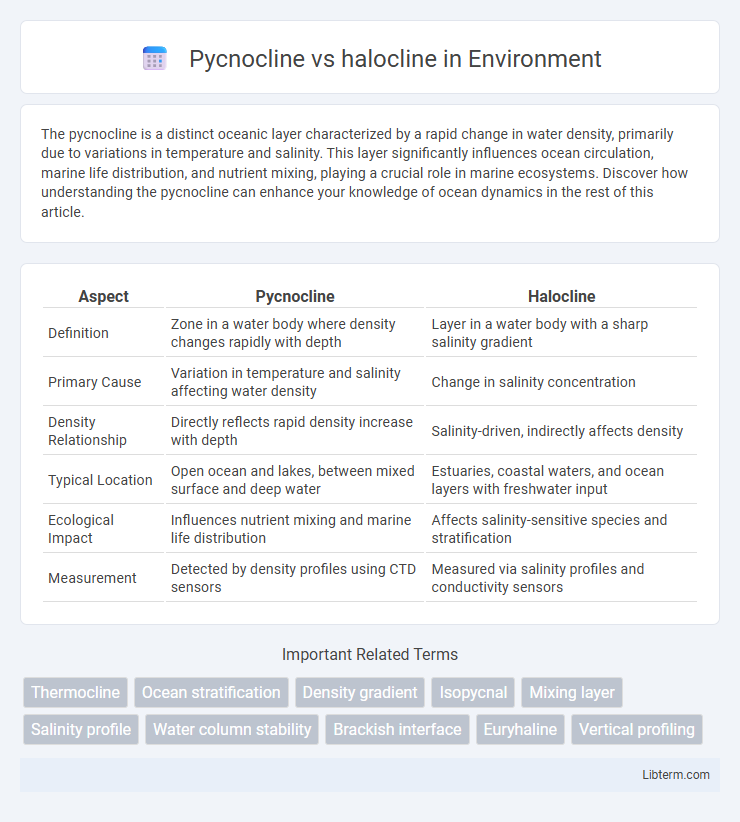The pycnocline is a distinct oceanic layer characterized by a rapid change in water density, primarily due to variations in temperature and salinity. This layer significantly influences ocean circulation, marine life distribution, and nutrient mixing, playing a crucial role in marine ecosystems. Discover how understanding the pycnocline can enhance your knowledge of ocean dynamics in the rest of this article.
Table of Comparison
| Aspect | Pycnocline | Halocline |
|---|---|---|
| Definition | Zone in a water body where density changes rapidly with depth | Layer in a water body with a sharp salinity gradient |
| Primary Cause | Variation in temperature and salinity affecting water density | Change in salinity concentration |
| Density Relationship | Directly reflects rapid density increase with depth | Salinity-driven, indirectly affects density |
| Typical Location | Open ocean and lakes, between mixed surface and deep water | Estuaries, coastal waters, and ocean layers with freshwater input |
| Ecological Impact | Influences nutrient mixing and marine life distribution | Affects salinity-sensitive species and stratification |
| Measurement | Detected by density profiles using CTD sensors | Measured via salinity profiles and conductivity sensors |
Introduction to Water Column Stratification
Water column stratification occurs when distinct layers form due to variations in water density, primarily influenced by temperature and salinity. The pycnocline represents a layer with a rapid density increase, mainly driven by temperature changes, while the halocline is characterized by a sharp salinity gradient affecting density. Understanding the interaction between pycnocline and halocline is crucial for studying ocean circulation, nutrient distribution, and marine ecosystems.
Defining Pycnocline and Halocline
The pycnocline is a distinct oceanic layer characterized by a rapid increase in water density with depth, primarily caused by changes in temperature and salinity. The halocline refers specifically to a layer within a body of water where there is a sharp gradient in salinity, resulting in changes in water density that influence marine stratification. Both pycnocline and halocline impact marine ecosystems by affecting vertical mixing and nutrient distribution.
Physical Basis: Density, Salinity, and Temperature
Pycnocline is the layer in the ocean where water density increases rapidly with depth, primarily due to changes in temperature (thermocline) and salinity (halocline). Halocline specifically refers to the zone where salinity gradients dominate density variations, causing significant shifts in water density independent of temperature changes. Understanding the interplay between temperature and salinity gradients within the pycnocline and halocline is crucial for studying ocean stratification and circulation patterns.
Formation Processes of Pycnocline
The pycnocline forms primarily due to variations in water density driven by changes in temperature and salinity, where temperature gradients (thermocline) often play a dominant role in establishing density stratification. In regions with significant freshwater input or evaporation, salinity differences also contribute, linking halocline formation to pycnocline structure through salinity-induced density changes. The interplay between temperature-driven thermocline and salinity-driven halocline results in the dynamic formation of the pycnocline, which acts as a critical density gradient separating surface and deep ocean layers.
Mechanisms Behind Halocline Development
Halocline development is driven primarily by variations in salinity caused by freshwater input, evaporation, and ocean currents, creating a distinct vertical gradient in salt concentration. This salinity stratification increases water density with depth, inhibiting vertical mixing and forming a stable halocline layer. Pycnoclines, in contrast, arise from combined temperature and salinity effects on density, but haloclines specifically emphasize salinity-induced density gradients as the key mechanism.
Geographic and Oceanographic Distribution
The pycnocline is a layer in the ocean where water density increases rapidly with depth, predominantly driven by temperature changes, and is commonly found in temperate and tropical regions with strong solar heating. The halocline is a depth zone where salinity changes sharply, frequently occurring in estuarine and polar environments where freshwater input or sea ice melt affects salinity gradients. Geographic distribution of pycnoclines is often broad across open oceans, whereas haloclines are more localized, coinciding with areas of significant freshwater influx or ice formation.
Pycnocline vs Halocline: Key Differences
Pycnocline refers to the ocean layer where water density rapidly changes with depth, primarily influenced by temperature and salinity variations. Halocline specifically denotes the layer characterized by a sharp salinity gradient, which can significantly impact water density but is distinct from pycnocline, as it focuses solely on salinity changes. Understanding the key differences between pycnocline and halocline is essential for studying ocean stratification, marine ecosystems, and nutrient mixing processes.
Role in Marine Ecosystems
The pycnocline and halocline play crucial roles in marine ecosystems by influencing water column stability and nutrient distribution. The pycnocline, defined by a rapid increase in water density with depth, often restricts vertical mixing, thereby creating distinct habitats and affecting oxygen and nutrient availability. The halocline, characterized by sharp salinity gradients, impacts osmoregulation for marine organisms and acts as a barrier to the movement of species between different salinity zones, further shaping biodiversity and ecosystem dynamics.
Impacts on Ocean Circulation and Mixing
Pycnocline, characterized by a sharp density gradient primarily driven by temperature and salinity, significantly influences ocean stratification and limits vertical mixing, thereby affecting nutrient transport and heat distribution. Halocline, defined by a steep salinity gradient, also contributes to density stratification but plays a more localized role in modulating water mass formation and haline-driven circulation patterns. The interplay of pycnocline and halocline structures shapes thermohaline circulation, with pycnocline exerting broader control on global ocean currents and halocline impacting salinity-driven regional mixing processes.
Environmental and Climate Change Implications
Pycnoclines and haloclines play critical roles in ocean stratification, affecting nutrient distribution and carbon sequestration processes essential for regulating global climate. Variations in pycnocline strength, driven by temperature changes, influence vertical mixing, impacting marine ecosystems and atmospheric CO2 exchange. Changes in halocline dynamics, primarily controlled by salinity gradients, affect ocean circulation patterns that modulate heat distribution and climate variability in polar and subtropical regions.
Pycnocline Infographic

 libterm.com
libterm.com